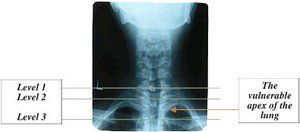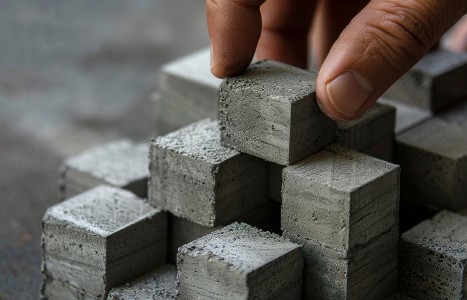Because traditional Chinese medicine (TCM) views the human body as an interconnected network of energy (qi) and seeks to restore balance and harmony, ensuring the smooth flow of qi and blood is crucial to nourish and regulate the reproductive system. TCM treatment aims to regulate menstruation, reduce anovulatory menstruation, help ovulation, improve egg quality, stabilize progesterone, and provide a good endometrium environment for successful implantation and pregnancy.
Preventing Pneumothorax
An insurance company in the U.S. that covers acupuncturists, reported lately that in the last four years, two acupuncturists were sued for allegedly causing a needle-induced pneumothorax.1 In one case, the patient was needled in right lateral position at LU 1, and rolled over onto the needle to precipitate an accident. In another monograph reported in the British Medical Journal,2 pneumothorax was reported in countries as far apart as Australia, where it was seen at a chest X-ray session, and in Japan, where a needle was seen on tomography.
In the large number of pneumothorax cases reported worldwide, it is unclear if the studies list largely doctors who practice acupuncture, or licensed acupuncturists. Again, no studies (or very few) seem to have excluded spontaneous pneumothorax as the main, or at least subsidiary, cause of the accident. This fact becomes significant when it is realized that in the United States every year, as many as 8,000 to 9,000 people develop spontaneous pneumothorax.3
In this discussion, the point GB 21, jianjing ("Shoulder Well"), will mainly be discussed, as it figures large in the array of points that cause a pneumothorax.
Noteworthy Peculiarities About This Point
I. It is the highest point on the trapezius in the sagittal plane.4
II. It sits astride on the very apex of the lung, which rises in a dome, bilaterally.
III. If an insertion is done using a perpendicular trajectory, an injury is likely.
IV. Any usage must factor in the rise of lung tissue at inspiration.
V. If the point is needled in any position but prone, the risk increases greatly.
VI. If the patient coughs or sneezes, the danger becomes manifold.
VII. In tall men, and in smokers between the ages of 20-40, the risk of spontaneous pneumothorax is significant.
VIII. Constant supervision is necessary at all times during treatment if this point is used.
IX. The risk of accident increases if the risk was not explained to the patient.
X. In a bony, thin man or woman, the hazard increases greatly.
XI. In a person with concomitant scoliosis, lordosis and kyphosis, risk increases.
GB 21 Visualized on a Radiological Plate

The vulnerability of the lung at its apex is readily visible in the plate below. Note that the ribs as they originate at the spine are placed considerably superior to the level at which the medial end of the clavicle articulates with the sternum. In that sense, if seen from the lateral perspective, and tending from back to front, the costo-spinal articulation of the first rib, the apex of the lung under the trapezeus muscle, and the claviculo-sternal articulation form a sort of a three-step descent. GB 21 locates at the critical second step, and in its needling, this anatomical arrangement should be kept in mind.
Level 1 - costo-spinal articulation
Level 2 - apex of the lung
Level 3 - claviculo-sternal articulation
Red arrow marks the exact level of apex of the lung
An Ideal Way to Needle This Point
- Explain the process and the need to use this point to the client.
- Explain the necessity during treatment to lay still and not move about to avoid injury.
- Discuss the need to use this point with the patient, and do so only after concurrence.
- Position the patient prone, comfortably, with face in a comfortable face-holder.
- The safest mode is a posterior oblique insertion, 0.5 to 1 cun.4*
- It is desirable to needle at and of expiration, when the chest is quiescent.
- The point, seen from the posterior aspect, lies midway between the tip of acromion and DU 14.4
* This is the Chinese usage, which explains the minimum and maximum depths of insertion. The author has found it as effective to use a Japanese style, minimal insertion, often of as little as 2 mm.
Intensity of Stimulation
Much depends on the style one uses, and the goal one wants to attain. The Chinese classical approach is to "move qi," to replenish what is deficient, and to empty what is full. The Japanese approach, one of which follows the Matsumoto school of thought,5 works more with creating homeostasis, equilibrium in the flow of qi, by removing stagnation. In that sense, the stimulation of the latter school is minimal, often with tiny thread-sized moxa being employed with and apart from the needling.
Another important aspect which influences relative risk is the type of stimulation in the two systems; the Chinese follows the rotation-lift and thrust method, whereas the Japanese Matsumoto approach works with linear thrusts, with minimal amplitude, often as little as 1-2 mm. The risk of a pneumothorax then obviously increases with the Chinese classical manipulation, and remains significantly low with the Japanese approach described here. It must be noted that there are many schools of thought with varied approaches; the ones described are circumscribed, and oriented to the topic under discussion.
Conclusion
In conclusion, with more physicians and allied health professionals opting to integrate acupuncture in their practice, and an increasing number of acupuncturists graduating every year, the field is likely to become more competitive, with increasing patient awareness and expectations.
Now is the time for professionals of all persuasions, the general public, and the insurers to work together toward increased awareness and prevention of accidents, for even one pneumothorax is one too many, because it puts a vital, living human, who has come seeking healing, in harm's way.
Endnotes
- Caycee Jones, LAc, author. Malpractice Claims Against Oriental Medical Practitioners. Professional Liability Director servicing a malpractice co.; Secretary of Georgia State Oriental Medicine Association.
- E Ernst, AR White, authors. Acupuncture may be associated with adverse effects. British Medical Journal, Feb 19, 2000.
- Spontaneous pneumothorax. Reported on AllRefre.com.
- Peter Deadman, Mazin Al-Khafaji, Kevin Baker, authors. A Manual of Acupuncture. Eastland Press: 2001. Gall Bladder channel, p. 438. E-mail: info@jcm.co.uk
- Kiiko Matsumoto and David Euler. Keiiko Matsumoto's Clinical Strategies, In the Spirit of Master Nagano, vol. 1. Published by Kiiko Matsumoto International, Natick MA, 2002. See chapter on stagnation of blood, and concepts of oketsu, a sort of blood stasis, and kori, an extension of it, p. 42.
More Links
- A study in which clinical signs and chest X-ray films confirm presence of a left-sided pneumothorax, with intercostal drainage giving immediate relief. JSM Leung, FRCS (Edin), FHKAM (Surgery), St Paul's Hospital, 2 Eastern Hospital Road, Causeway Bay, Hong Kong. http://www.hkam.org.hk/publications/hkmj/article_pdfs/
hkm0206p225a.pdf - Spontaneous pneumothorax, incidence, and epidemiological profile. http://www.lung.ca/diseases/sponpneumo.html
- Discussion on results of pneumothorax and guidelines to deal with it. http://www.pulmonaryreviews.com/jan00/pr_jan00_spontaneouspneu.html
- Patient education brochure listing risks of pneumothorax during acupuncture treatment and strategies to prevent. Dr. Holmes Keikobad, author. Published by Tru Self, Inc., 7724 E Meadowbrook Ave., Scottsdale, AZ 85251. For copies in bulk for front office, call 1-888-878-7353 or e-mail: acuheal@earthlink.net



